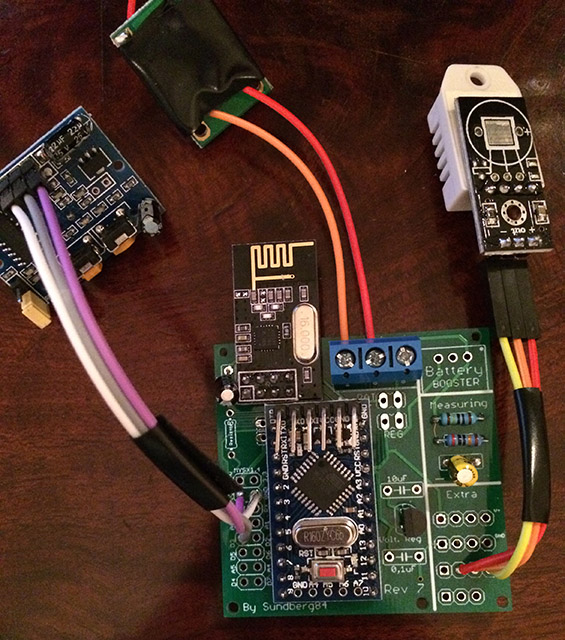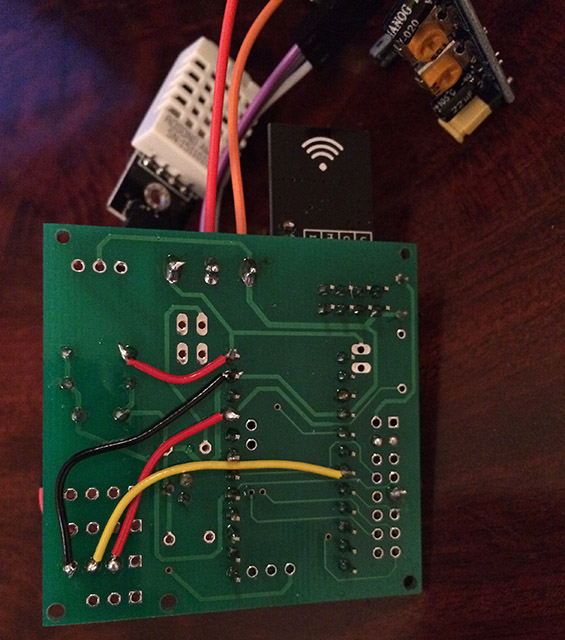Motion Sensor triggering on its own
-
I have for a sonar sensor (Ultrasonic Module HC-SR04) used in RPI and written in Python, used to measure 3 times and if all 3 measurements are same, then result is valid and data send. This is working perfect for me. You can create something similar for your Arduino
intdistance = 0
distance = -1 continueLoop = True log.debug("Loop until distance1 = distance2 = distance3") while(continueLoop): #distance = ser.read(size=3) distance = ser.readline() getValue1 = distance.rstrip('\r\n') log.debug("distance1: %s", getValue1) distance = ser.readline() getValue2 = distance.rstrip('\r\n') log.debug("distance2: %s", getValue2) distance = ser.readline() getValue3 = distance.rstrip('\r\n') log.debug("distance3: %s", getValue3) distance == getValue1 if getValue1 == getValue2 and getValue2 == getValue3 : continueLoop = False intdistance = int(distance) log.info("distance: %d to be sent to Agocontrol", intdistance) -
The same problem for me. Different HC-SR501 sensors (connected to one of three nodes with this sensors) periodically entering "flood mode" with continuous sending 1/0 values. I suspect that this is power supply related problems.
@robosensor Have you tried to enable the ibternal pullup for the pin?
-
@robosensor Have you tried to enable the ibternal pullup for the pin?
@Jan-Gatzke said:
@robosensor Have you tried to enable the ibternal pullup for the pin?
Didn't read biss0001 datasheet, so I don't know is output pin 5V-compatible (for pullup) or not, so I didn't tried to enable internal pullup.
In any case I will try to check what happens with OUT pin of module during this 1/0 flood.
-
Thanks @Jan-Gatzke it did not work for me this time.
I'm using a 5v Arduino Pro mini and when i measure the power on the HC-SR501 i get 3.71v.
When i measure the power on the VCC i get 3.69v and when i measure the RAW i get 5.43v.Here you can se how everything is wired, I use the Easy/Newbie PCB by @sundberg84.


First i used the 5v cable to the raw on the PCB and then it did't work.
When I change to connect to the PWR then it works. Don't know why. Maybe @sundberg84 know why? -
Hi @ErrK.
Work your way backwards with the multimeter. Are you powering with 5v there shouldnt be a drop to 3v. Check volt over arduino and then vcc output. As i said work you way backwards in the circuit.
I suspect a faulty hardware somewhere, measure the input and output on the voltage regulator on the arduino.
-
@Maciej-Kulawik Thanks.
Today my second node started to do this too.
I have tried to change the HC-SR501 and the problem seams to be on the node and not on the sensor.
Can i see how you fixed this in the sketch?@ErrK In my case PIR switches into HIGH for some seconds (depending on potentiometer), so reading after 100ms will give the same value.
@ErrK Unfortunately my solution is not 100% reliable. For 2 of my nodes it works well, but for 3rd node (the same hardware, the same sketch, only PCB is a little bi different - previous version, but difference only in dimension) - pir is false triggerring almost each minute (sometimes with 2 minutes delay with false triggering). And I checked - it is not caused by NRF sending. I have no idea whats going on.
-
@Maciej-Kulawik , how are you powering the node? I had once a PIR false-triggering due power instabilities...
-
Hi,
i'm wanted to share my experience also with those sensor.
I had a lot of issue with false trigger when running on 3.3V. In my case the power was definitely the issue.
it's looks like sleeping the radio/mcu cause some noise on the voltage line.I solve 100% of my false trigger issue when doing a small sleep, before enabling the sleep with interrupt.
gw.sleep(500); gw.sleep(INTERRUPT,RISING, SLEEP_TIME); -
@Maciej-Kulawik , how are you powering the node? I had once a PIR false-triggering due power instabilities...
@rvendrame I'm powering all with 2xAA baterries. On PIR I removed regulator. The problem with false trigerring is independent from voltage level. It is the same if I put old baterries (2,8V) or brand new (3,2V).
@fifipil909 I also suspect that it is somehow connected to powering noises and mcu sleeping. In my one case PIR is triggering each minute - and sleep time is also one minute. -
@Maciej-Kulawik , maybe if you try to power the PIR with +5V for a while and watch the results? Don't forget to keep all GNDs inter-connected...
-
I'm also having this issue at 3V. It gets triggered if there is a (little) voltage drop. All my pirs only wake with an interrupt and no timer, then it works fine. But with a sleep timer it won't work the normal way.
At 5V everything works fine.
Maybe @fifipil909 's solution works.
-
I was testing the below sensor with 3.3v and it was reporting false status. It worked well with 5v. Although the site claims it works between 3 to 5 volts.
Maybe power issueshttp://store.fut-electronics.com/products/pir-motion-sensor-module-adjustable-range
-
I was testing the below sensor with 3.3v and it was reporting false status. It worked well with 5v. Although the site claims it works between 3 to 5 volts.
Maybe power issueshttp://store.fut-electronics.com/products/pir-motion-sensor-module-adjustable-range
@ahmedadelhosni All those PIRs are built using the same chip. All all have 3,3v regulator onboard, so they always work with 3,3v. I don't understand why powering directly with 3,2v from battery makes so trouble.
Maybe this LDO regulator adds some additional stabilisation/filtering on power line, when powered with greater voltage... -
@ahmedadelhosni All those PIRs are built using the same chip. All all have 3,3v regulator onboard, so they always work with 3,3v. I don't understand why powering directly with 3,2v from battery makes so trouble.
Maybe this LDO regulator adds some additional stabilisation/filtering on power line, when powered with greater voltage...@Maciej-Kulawik It can be that the on-board LDO needs more than 3.3v to activate. It maybe even dropping the voltage from batteries, and doing nothing but disturbing :-) Maybe it worth to remove it when running the circuit with 3V from batteries.
-
@Maciej-Kulawik It can be that the on-board LDO needs more than 3.3v to activate. It maybe even dropping the voltage from batteries, and doing nothing but disturbing :-) Maybe it worth to remove it when running the circuit with 3V from batteries.
@rvendrame But I work only with pirs with ldo removed (and diode).
-
@rvendrame But I work only with pirs with ldo removed (and diode).
@Maciej-Kulawik if so, your PIR looks to need at least 3.3V, so the ~3V from 2xAA is not enough and it is causing instabilities (probably the same as reported by others here).
-
@ahmedadelhosni All those PIRs are built using the same chip. All all have 3,3v regulator onboard, so they always work with 3,3v. I don't understand why powering directly with 3,2v from battery makes so trouble.
Maybe this LDO regulator adds some additional stabilisation/filtering on power line, when powered with greater voltage...@Maciej-Kulawik I didnt know that info. Thanks.
-
Did you guys get them working? I tried to power the pir sensor via the "H" pad directly with 3.3V from a boost converter (via a coin cell). Now I get random readings that I didn't have when using a stable 3.3V source. Any ideas how to solve this?
I haven't (yet) removed the voltage regulator on board. Perhaps that might help... -
Hi,
False detection is only due to power stability issue.
Personnaly i remove the regulator and power the PIR without any boost on the VCC pin. Even below 2v the PIR continue working without any a single issue.Did you try to do a small delay before sleeping with interupt ? See my post a bit upper.
For me it solve all my false trigger issue.
